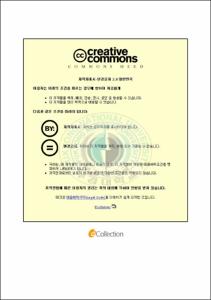확인요구 모달리티의 정보성
- Alternative Title
- THE INFORMATION OF CONFIRMATION DEMAND MODALITY
- Abstract
- This study is to find out differences of the information domains between the speaker and the listener focused on the basic forms of confirmation demand modality“ZYANAIKA”“DAROU”and“NE”, and to analyze them to know the confirmation of information. For this purpose, the research has been referred the scripts of Japanese movies, dramas and animations.
The confirmation demand modality means that there exists the speaker and the listener in the communication and the speaker expects and demands the listener’s judgment to the recognition of the situation. This modality commonly uses rising intonation, which shows an interrogation to the listener.
There are three forms of the confirmation demand modality, “ZYANAIK A”,“DAROU”and“NE”. “ZYANAIKA”involves the meaning of the speak er’s confirmation of information and this is the confirmation demand modality which leads the listener to agree that the speaker’s information is correct. “DAROU”leads the listener to speak when the speaker recognizes it while this modality is likely to depend on the listener for information when the speaker doesn’t recognize it. In the case of using“NE”, the speaker has a nuance that the speaker identifies his information according to the confidence to the listener’s information because the speaker has lack of confidence to his information.
According to the tendency of the listener’s informational dependence, three forms of confirmation demand modality can be expressed like this: “ZYANAIKA”<“DAROU”?“NE”. In this expression, “DAROU”, which is the listener dependent form, means that there is no information to the speaker.
When “DAROU” is the listener leading form, it can be expressed like this: “DAROU”<“ZYANAIKA”
This expression means that“DAROU”shares the listener’s information with the speaker while“ZANAIKA”leads the listener’s information to confirm the speaker’s information. On this occasion, “NE” cannot be used similarly, for “NE” is not the kind of modality to lead the listener’s information.
When“DAROU”is the listener dependent form, these three forms of modality, according to the confirmation of the speaker’s information, can be expressed like this: “DAROU”?“NE”<“ZYANAIKA”.
In the sense of the information concerning, “DAROU” and “NE” are considered having same meaning, but “NE” shows more confirmation.
- Issued Date
- 2008
- Awarded Date
- 2008. 8
- Type
- Dissertation
- Keyword
- 확인요구 모달리티 DEMAND MODALITY 정보적 관계
- Publisher
- 부경대학교 교육대학원
- Alternative Author(s)
- Lee, Ji Young
- Affiliation
- 부경대학교 교육대학원
- Department
- 교육대학원 일어교육전공
- Table Of Contents
- Ⅰ. 서론 = 1
1. 연구의 목적 = 1
2. 선행연구 = 2
3. 연구의 구성 및 연구 방법 = 9
Ⅱ. 모달리티의 구조 = 12
1. 모달리티의 범주와 특징 = 12
가. 판단주체의 주관성 = 12
(1) 인간 내면의 감정과 사고 = 12
(2) 피해수동표현 = 13
(3) 시점의 이동현상 = 14
나. 표현주체의 주관적 사항 = 15
(1) 표현자와 청자의 문제 = 15
(2) 담화의 신규요소 도입문제(田窪論) = 16
2. 문(文) 구조에 있어서의 모달리티 = 17
가. 주관적인 판단 표현태도를 나타내는 요소 = 17
나. 객관적으로 파악된 사항을 나타내는 요소 = 18
3. 확인요구모달리티 = 19
가. 확인요구의 정의 = 19
나. 확인요구의 구성과 특징 = 20
Ⅲ. 「じゃないか」「だろう」「ね」의 비교·분석 = 23
1. 「じゃないか」「だろう」「ね」의 의미 분석 = 23
가. 「じゃないか」 = 23
나. 「だろう」 = 27
다. 「ね」 = 32
2. 정보적 관계 = 38
가. 청자 의존형 = 38
(1) 정보적 공기(共起) = 38
(2) 호환성 = 42
나. 청자 유도형 = 43
(1) 정보적 공기(共起) = 43
(2) 호환성 = 46
다. 정보의 확신성 = 51
(1) 「じゃないか」와「ね」 = 51
(2) 「だろう」와「ね」 = 52
(3) 「じゃないか」와「だろう」 = 53
Ⅳ. 결론 = 55
참고문헌 = 58
〈표 및 그림 차례〉 = 20
[표1] 〈요구표현의 구성요소〉 = 20
[표2] 〈청자와 화자간의 정보적 관계〉 = 56
[그림1] 〈「だろう」「ね」「じゃないか」의 청자의 정보적 인식관계〉 = 50
- Degree
- Master
- Files in This Item:
-
-
Download
 확인요구 모달리티의 정보성.pdf
기타 데이터 / 881.76 kB / Adobe PDF
확인요구 모달리티의 정보성.pdf
기타 데이터 / 881.76 kB / Adobe PDF
-
Items in Repository are protected by copyright, with all rights reserved, unless otherwise indicated.